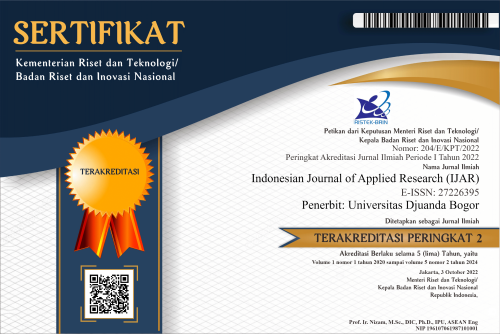Effects Drying on The Indonesian Citrus Peel Antioxidant Activity
Abstract
The high production and market demand of citrus fruits for household and industrial consumption make it peels one of the most abundant wastes found in the environment. On the other hand, citrus peel is well known for bioactive compounds that beneficial to human health, including phenolic, flavonoids, and antioxidants. Recently, citrus peel waste is starting to be used for food ingredients. The drying technique is one of the solutions that can be used for preserving citrus peel waste which has high water content. This study was objected to identifying the effect of the drying type (tray dryer and freeze dryer) on the antioxidant activity alteration of three citrus varieties that commonly cultivated in Indonesia, i.e. pummelo/jeruk Bali (C. maxima Herr.), mandarine citrus/jeruk keprok (Citrus reticulate) and sweet orange/tangerine/jeruk Medan (C. microcarpa L. and C. sinensis L.). The antioxidant activity was measured by calculating the IC50 value. The results showed ethanol extract of fresh mandarin citrus peels showed the lowest IC50 (14.46 ± 3.63 mg/mL) compared to fresh pummelo peels (26.48 ± 5.17 mg/mL) and fresh tangerine peels (16.94 ± 1.51 mg/mL). Tray dryer technique reduced the IC50 value of the peel extracts of pummelo, mandarine citrus and tangerine were 78.92%, 72.34%, and 79.69%, respectively. Whereas Freeze dryer drying reduced the IC50 value of pummelo, mandarine citrus and tangerine peel extracts were 59.21%, 69.43%, and 80.46%, respectively.
Copyright (c) 2020 Indonesian Journal of Applied Research (IJAR)

This work is licensed under a Creative Commons Attribution-ShareAlike 4.0 International License.
The Authors submitting a manuscript do so on the understanding that if accepted for publication, copyright publishing of the article shall be assigned/transferred to Indonesian Journal of Applied Research (IJAR) Universitas Djuanda as Publisher of the journal. Upon acceptance of an article, authors will be asked to complete a 'Copyright Transfer Agreement'. An e-mail will be sent to the corresponding author confirming receipt of the manuscript together with a 'Copyright Transfer Agreement' form by online version of this agreement.
Indonesian Journal of Applied Research (IJAR) Universitas Djuanda, the Editors and the Editorial Board make every effort to ensure that no wrong or misleading data, opinions or statements be published in the journal. In any way, the contents of the articles and advertisements published in the Indonesian Journal of Applied Research (IJAR) Universitas Djuanda are sole and exclusive responsibility of their respective authors and advertisers.
Remember, even though we ask for a transfer of copyright, our journal authors retain (or are granted back) significant scholarly rights as mention before.
The Copyright Transfer Agreement (CTA) Form can be downloaded here: Copyright Transfer Agreement-IJAR 2020
The copyright form should be signed electronically and send to the Editorial Office e-mail below:
Prof. Dr. Ir. Dede Kardaya, M.Si. (Editor-in-Chief)
Universitas Djuanda
Jl. Tol Jagorawi No.1, Ciawi, Kec. Ciawi, Bogor, Jawa Barat 16720
Website: http://journal.unida.ac.id/index.php/IJAR/index
Email: ijar@unida.ac.id






 This work is licensed under a
This work is licensed under a 